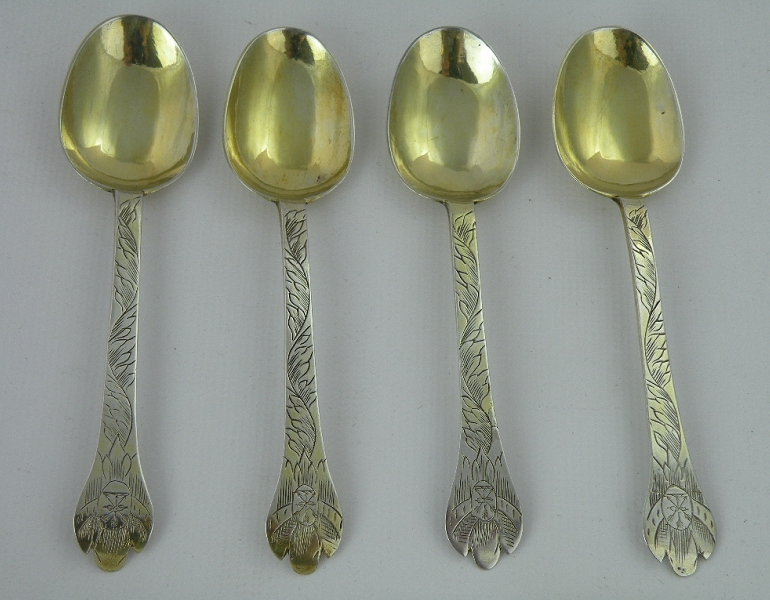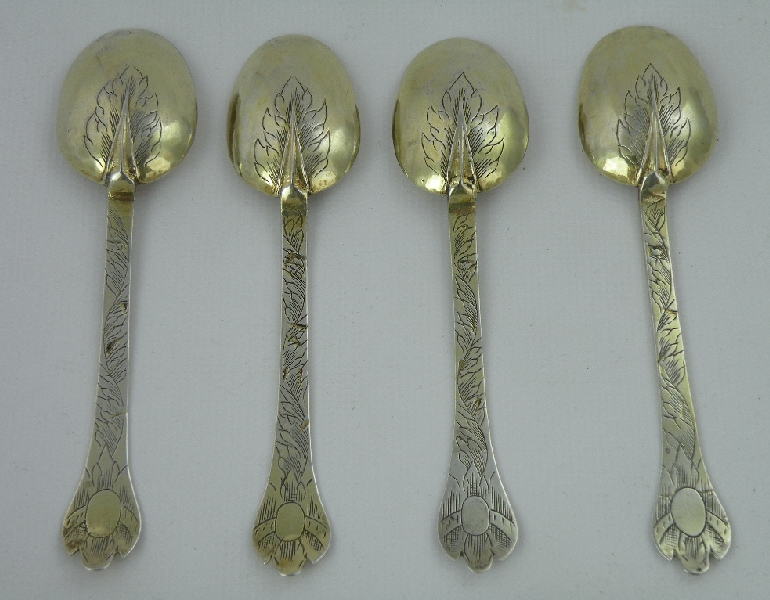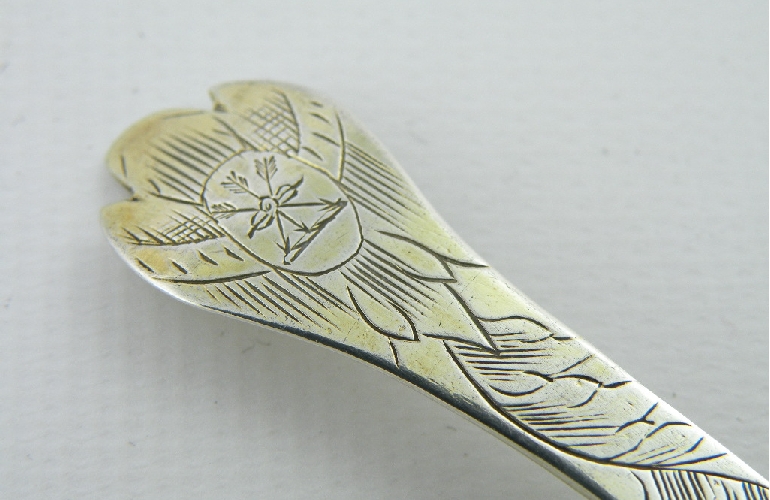My Gallery - Trefid type spoon (1660s-1700)
 A set of Trefid type Silver-gilt Flatware, two of the spoons with maker's mark of Thomas Tysoe, the rest with maker’s mark IH crown above, Jean Harrache. Given their early date and fine condition this service of unusually small spoons, forks and knives represent a remarkable survival. Flatware of this size was intended for use with sweetmeats which would have been served separately from the main meal. Spoons: 4 in 10.3 cm, Forks: 3 7/8 in (9.8 cm) , Knives: 4 7/8 in (12.5 cm),
Weight: 2 oz 10 dwt (78 g) Dating from the post Commonwealth period, around 1660, the Trefid style spoon appeared. The style, completely different from the traditional English spoon maintaining its style since Roman period, was imported from France with new table manner. Its prototype would be derived from the Chinese spoon which has a flat stem engraved with froral motifs and Chinese arabesque. However the diagnostic terminal where the stem is divided into three sections and a rat-tail shaped ornament on back of the bowl are unique characteristics of the trefid style.
A set of Trefid type Silver-gilt Flatware, two of the spoons with maker's mark of Thomas Tysoe, the rest with maker’s mark IH crown above, Jean Harrache. Given their early date and fine condition this service of unusually small spoons, forks and knives represent a remarkable survival. Flatware of this size was intended for use with sweetmeats which would have been served separately from the main meal. Spoons: 4 in 10.3 cm, Forks: 3 7/8 in (9.8 cm) , Knives: 4 7/8 in (12.5 cm),
Weight: 2 oz 10 dwt (78 g) Dating from the post Commonwealth period, around 1660, the Trefid style spoon appeared. The style, completely different from the traditional English spoon maintaining its style since Roman period, was imported from France with new table manner. Its prototype would be derived from the Chinese spoon which has a flat stem engraved with froral motifs and Chinese arabesque. However the diagnostic terminal where the stem is divided into three sections and a rat-tail shaped ornament on back of the bowl are unique characteristics of the trefid style.
In this period the spoon started to be differenciated in response to its usage. This coincided with new table manner. A small trefid spoon was originally made for sweetmeat however it also started to be used as a tea-spoon. It adjusted its size to match with size of a porcelain tea-cup and saucer imported from China or Japan. It was around 1650 that Tea-drinking in England started. The trefid style tea-spoon was a newly invented utensil only for Western style tea-drinking.
Around 1700, when the Trefid was superseded by the dog-nose spoon, a multitude of variations of spoon occurred.
The most beautiful trefid style spoons are the lace-backs and flame-backs type. The lace-backs have intricate chasing to the reverse of the bowl, and occasionally to the front stem terminal. The flame-backs have very ornate all over engraving often obliterating the hallmarks.
Variations in the three lobed terminal, and the decoration around the rat-tail to the reverse of the bowl (e.g. beaded rat tails, and reeded rat tails), are also sought after.
Trefid type Silver-gilt Teaspoon, Netherland (?), circa 1680
A Trefid type silver-gilt teaspoon made in probably Netherland, circa 1680. The lotus flower and scrolling arabesque design was finely engraved. This type of decoration would be originally inspired by Chinese spoons and simplified by Europeans. The unknown hallmark is clearly beared
Dimensions: 112mm long
A set of 4 Trefid Spoon by William Mathew, London, circa 1680s
A set of 4 William & Mary period trefid teaspoons retaining much of their original gilding. The spoons retain their original engraved design in crisp condition and bear late 18th Century crest to the front terminals. Typically the hallmarks are lost within the engraving (i.e. the spoons were hallmarked first and engraved by the silversmith on their return from assay) however the punch shapes can still be seen and the makers mark.
Dimensions: 112mm long
William Mathew
He was a son of Thomas Mathew late of Woolventon (?) in the County of Worcestor. He apprenticed to John Smith on 28 July 1675 from 'Midsummer last'.
He became Free on 27 June 1683. Then he probably registered his mark "WM crowned" on London Assay Office. This maker's mark “WM crowned” is recorded on page 141 of Jackson’s Silver & Gold Marks. The book reads that Wm. Mathew, free 1683 (K) and the mark was recorded in 1684-85 (Trefid spoon), 1688-89 (Trefid spoon), 1690-91 (Spoon), 1692-93 (Spoons), 1694-95 (Spoons).
Grimwade's London Goldsmiths 1697-1837 Their Marks & Lives attributed the mark “MA” (1976-7, 3730) to William Mathew (I) who entered his first mark as largeworker, undated, probably April 1697 on commencement of register. Address: Foster Lane. And second mark was registered on 23 May 1700. However this is due to the fact that Grimwade's book starts from the year 1697, as this was when the New Standard (Britannia 958 purity) was introduced and all makers had to enter a new mark using the first two letters of their surname.
These teaspoons therefore pre-date 1697, the starting point of Grimwades book.




 Top
Top Site Map
Site Map References
References About Me
About Me